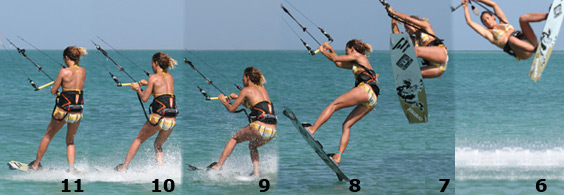Double Front Loop Down Loop Transition
One of the advanced level tricks in Kite surfing is the double front loop transition. This is tried by mostly experts or advanced intermediate surfers. The technique here is mostly based on how you balance your forward momentum on the board and then move to height and bring yourself down on the downward wind and this is where you try out the perfect rotation of yourself. So to approach this trick there are couple of steps you need to follow.
First thing you need to do is basically place yourself on the board. This is done with the right leg placed straight on the board with the left leg behind in such a way so that it is used for pushing the board. As the wind speed increases the kite will start to lift you up and this is the point you need to start rotating yourself. Make sure you do not bend the back legs from the board as this basically slows down the entire rotation obstructing the perfect transition. The main idea here is to take you up on the first rotation and slide down in front for a smooth landing but you will notice that by the time you finish the first rotation and shift your head on the other side you are again ready to go for the second time. The next step is here when you and the kite are lifted up and you need to stay at 12 o’clock to the kite all this time by controlling the kite bar with front hand pulling it in forward direction. Every time you jump up the kite should be at 12 o’clock position and this is done when you rotate the body but your feet should be on the board. The impressive part of this is when you are lifted in the air and try to come down it descends slowly and gives you a feel of the kite and its forward movement.
A point to remember here is the kite should be always above you during this time otherwise the downward loop will pull the kite in front and you will be away from it. Always remember that the downloop will be slow and steady so that during this movement it will land you and also has the force to pull you forward. In fact you do not need to make the whole 720° as the downloop which helps in the smooth transitioning to landing also takes care of the turnings. But this is different from kite to kite and it matters on the sizes. For instance if you are using a kite which is slightly larger than the common ones available then make sure the front hand which is over the bar to move in the forward direction to control the high speeds which is controllable with two hands in case the kite is smaller. As you move forward with the wind, you will soon realize that how the kite quickly understands where to downloop and the downwind along with it also assists you in landing your kite.
Front Loop Kiteloop
This is a stunning move for those that really like ballsy tricks where it is all about setting up everything perfectly. Before going through the move, it is encouraged to simply “go earlier” and “pull of your life”, stepping it up a gear so you get focused on the move. This trick is all about commitment, once you have set the wheel in motion, you are a whole lot better off going the nine yards than trying to make your way out. The good news, however, is that you can build up into this trick and therefore save yourself onto any unnecessary spankings.
To give yourself a good chance of nailing the front loop kiteloop, there are definitely a few things that you should be able to do. Due to the fact that you’ll be looping forwards whilst the kite loops backwards, you will perform this move blind, as all the action will be happening behind you. The base for learning this move is a front loop transition, so this needs to be solid. On top of that, this shouldn’t be the first kiteloop you are attempting, as you really need to have your fast and sometimes hard and difficult landings down.
FIRST STEPS
To get your head around the idea of what is going on we will start at the front loop transition. Normally as you exit the transition, you should dive the kite hard. This pulls you out of your rotation and encourages you to land downwind. Essentially this results in the kite diving straight down through the window, and it usually takes a fair old tug to stop the kite from hitting the water. It is then when you carve back onto your edge and the kite rising which takes you back in the other direction.
Once you done a few front loop transition and feel comfortable with the approach. As you exit the move, just as your board touches down pointing off wind, rather than pulling the kite back up, pull harder with your back hand so that the kite loops under itself. This way you will follow the pull of the kite and carve out in the same direction that you went into the move, so no change in direction.
THE APPROACH
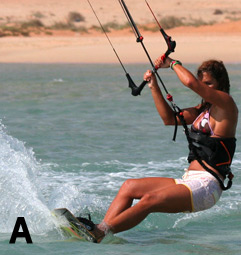 Pic A – Shows the surfer just before the take-off. If you look at her hand and the bar, you can see that the surfer has sent the kite back, but jump is not that aggressive. There are two reasons for this. First, you do not want to be jumping high because this move is all about commitment, make it easier to commit. Once you are three meters up, you may find the thought of looping your kite-less appeal. Second, you do not want your kite to go too far behind you. The further back it goes, the lower it will loop, which in turn means a heavier landing. Apart from the gentler sending, much as transition, the surfer is still carving hard against the kite off his back foot and dropping his weight against the upward pull of the kite.
Pic A – Shows the surfer just before the take-off. If you look at her hand and the bar, you can see that the surfer has sent the kite back, but jump is not that aggressive. There are two reasons for this. First, you do not want to be jumping high because this move is all about commitment, make it easier to commit. Once you are three meters up, you may find the thought of looping your kite-less appeal. Second, you do not want your kite to go too far behind you. The further back it goes, the lower it will loop, which in turn means a heavier landing. Apart from the gentler sending, much as transition, the surfer is still carving hard against the kite off his back foot and dropping his weight against the upward pull of the kite.
TIMING
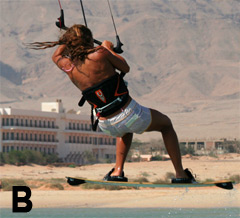 Pic B – The surfer is most definitely rotating into a front loop. You can see how far his front shoulder dipped still down from the take-off and that the surfer has already brought his legs up for balance and speed of rotation. However, the really exciting part of this picture is the bar. His back hand has slid all the away to the end of the bar, so the surfer can get decent purchase to crank the bar in and get the kite turning into its loop. It is also worth noting that the surfer has not pulled his front hand in. It is very easy to pull hard on the back hand and subconsciously pull down on the front hand too. Just keep the bar sheeted in with the front hand and let the back hand/arm do all the work. When learning this move, the harder you pull on the bar and the quicker the kite turns the gentler the kiteloop will be. From here there is no way back.
Pic B – The surfer is most definitely rotating into a front loop. You can see how far his front shoulder dipped still down from the take-off and that the surfer has already brought his legs up for balance and speed of rotation. However, the really exciting part of this picture is the bar. His back hand has slid all the away to the end of the bar, so the surfer can get decent purchase to crank the bar in and get the kite turning into its loop. It is also worth noting that the surfer has not pulled his front hand in. It is very easy to pull hard on the back hand and subconsciously pull down on the front hand too. Just keep the bar sheeted in with the front hand and let the back hand/arm do all the work. When learning this move, the harder you pull on the bar and the quicker the kite turns the gentler the kiteloop will be. From here there is no way back.
KITE CONTROL
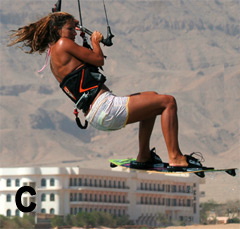 Pic C – To be in control of the kite and make sure it loops, you need to have tension on the lines. Here you can see that the surfer has the bar sheeted in, so the kite will react. Also by making a physical effort to keep the bar sheeted in, you are far less likely letting the bar slide out as the power comes on, which would unfortunately stop the kite from turning. An added bonus is that, as the looping kite pulls, you will feel it through your arms, not just your harness and thus, you will able to keep your balance more easily.
Pic C – To be in control of the kite and make sure it loops, you need to have tension on the lines. Here you can see that the surfer has the bar sheeted in, so the kite will react. Also by making a physical effort to keep the bar sheeted in, you are far less likely letting the bar slide out as the power comes on, which would unfortunately stop the kite from turning. An added bonus is that, as the looping kite pulls, you will feel it through your arms, not just your harness and thus, you will able to keep your balance more easily.
COMMITMENT
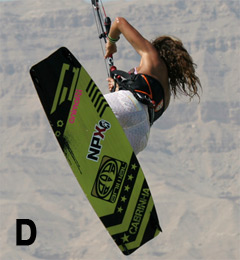 Pic D – The surfer has been pulled around his front loop by the looping kite and the pull of his harness hook. As long as the kite loops, you will always finish your rotation. Even though she is around, if you look closely, the surfer still has the bar pulled right in with both hands thus giving it plenty of hand. It is tempting to ease off because it will feel like the kite has turned further than it really has, but if you do, the best end is the splashing down in like a doggy transition. The surfer is also looking where to go. As a reference, try to look slightly behind of the downwind, this way you can land with speed and then carve out, and if you have looped the kite too fast, you can carve back from where you came, having turned the whole thing into a front loop kiteloop transition.
Pic D – The surfer has been pulled around his front loop by the looping kite and the pull of his harness hook. As long as the kite loops, you will always finish your rotation. Even though she is around, if you look closely, the surfer still has the bar pulled right in with both hands thus giving it plenty of hand. It is tempting to ease off because it will feel like the kite has turned further than it really has, but if you do, the best end is the splashing down in like a doggy transition. The surfer is also looking where to go. As a reference, try to look slightly behind of the downwind, this way you can land with speed and then carve out, and if you have looped the kite too fast, you can carve back from where you came, having turned the whole thing into a front loop kiteloop transition.
LOCOMOTION SEQUENCE
1. Approaching with speed, the surfer has a good check to see the room to get pulled back and downwind by looping the kite without risking anybody else. The surfer got a bit of water under too. The surfer sends the kite back positively, keeping the bar on the sweet spot.
2-3. As the front loop goes, the surfer throws himself forward and down as the kite lifts him up off the water. At this point the surfer levels the bar and sheets in.
4. As the surfer starts to rotate, sliding the back hand down the bar and pulls his knees up and then pulls hard on his back hand to get the kite looping.
5-7. To increase his chance of success, the surfer keeps pulling on his back hand to make sure that the kite turns all the way and also keeps the bar pulled in, so that there is tension on the lines and the kite does what the surfer expects.
8. So far all through the rotation, the surfer has been looking over his back shoulder. As the surfer gets most of the way around the loop and focuses on where to land.
9. With the kite powering around its loop, it spins the surfer around so that his harness hook is pointing at where the pull is coming, slightly behind of downwind. The surfer keeps the bar sheeted in and keeps turning the kite with his back hand.
10. This is the moment of most power as the kite starts to climb back up. The surfer keeps his knees up thus, pulling the bar with his hands to keep the balance.
11. The surfer has survived the loop and just need to stick the landing. With the power of the kite decreasing, the surfer starts to drop. This is his cue to let his feet drop beneath.
12. As his feet drops, the surfer aims for a downwind landing, concentrating on keeping his weight over the board and not to one side or the other.
13. The surfer lands tail first but onto a level board, so the surfer can soak up the speed. Once steady, the surfer carves back onto his edge, with a great relief plus the applause.
KEYSTONES
- Keep bar in to sweet spot on take-off.
- Move back hand down the bar.
- Start kiteloop as soon as you feel you are rotating under the kite.
- Keep both hands on the bar and keep the bar in.
- Look to land downwind over the board.
Here is a video of this trick
Unhooked Popped Front Loop
In continuation of out front loop fest, we thought it high time to introduce and familiarize the baby brother of the much respected S-bend, the Popped Unhooked Front Loop. Not only does this move dazzle, but also it is a foundation for a whole other world of kiting techniques that may or may not intrigue you. In addition to that, all this unhooked malarkey (if you’re tempted) is just as well practiced on those underpowered summer days, so give it a shot.
Popping, front looping and a basic unhooked Raley would be a small requirements, along with a modern safety system that lets you both spin and unhook without risking any third party members of the public or kite surfing community.
To help you learn all the important ingredients of an unhooked popped front, we’ll take another look at unhooking, a little glance at popping and way up the differences of popped front compared to a sent front loop.
DETACHMENT
The simplest way to make unhooking controllable is to understand how your kite is trim, thus your bar position will effect what’s going on.
For unhooking, it is vital that you use the strap to trim your bar’s sweet spot so that it rests just above the chicken loop. This way, the bar will feel light and the kite will drift forward, allowing you to be powered up yet in control. Every kite is unique, but it’s more time consuming getting it right. If you don’t trim the sweet spot down, your kite will most likely flare, pulling you off downwind, falling out of the sky in the calms and making kite surfing in general fairly unkind.
Pics 1 & 2. You can see that the surfer is sailing along hands centered with bar trimmed down, flattens the board off by abruptly standing up and almost carves, putting weight over the rear foot. This sudden change in direction towards the kite releases the tension off the lines.
Pic 3. With the tension gone, the surfer pulls the bar in and pushes it down to let the chicken loop slide out from the hook. Without looking down, as this would prevent the hips to move back and make unhooking difficult.
Pic 4. As the chicken loops drops out, the surfer must start to carve into pop before losing speed. Head positioned forward in direction as to where the surfer wishes to go, moves weight and hips right back over the rear foot and straightens the front leg, while dropping upwind off the board to get it back on an edge.
Pics 5 & 6. The surfer tries to maintain shoulders, back and front leg straight when carving hard against the pull of the kite. The goal is to explode up off the rear leg once it gets unstable, must also try and maintain equal pressure on both hands, as it is easy to pull on the back hand and hurl the kite up.
HANDS OF TIME
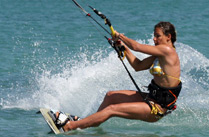 It is essential that you provide a good pop, as this will give you enough time to complete your spin. Your body position in the last stage of the carve will either offer you the chance to explode up or let you be dragged low over the edge which you do not want. In the picture to left, you can see that just before take-off, the surfer positioned the buttocks low to the water, shoulders have not been pulled forward the hips, front leg is extended to keep the edge and push the weight back over the tail of the board, rear leg is flexed in preparation to explode and is looking forward, which will prevent carving too far into the wind.
It is essential that you provide a good pop, as this will give you enough time to complete your spin. Your body position in the last stage of the carve will either offer you the chance to explode up or let you be dragged low over the edge which you do not want. In the picture to left, you can see that just before take-off, the surfer positioned the buttocks low to the water, shoulders have not been pulled forward the hips, front leg is extended to keep the edge and push the weight back over the tail of the board, rear leg is flexed in preparation to explode and is looking forward, which will prevent carving too far into the wind.
A PLACE IN THE SUN
To support this, don’t park your kite at a 45 degree angle, that’s for some time in the future. You need to catch a comfortable height where you are comfortable edging like this, without the kite providing too much lift, but which will also give you a tad of extra bounce off the water. 11 or 1 o’clock would be a decent place to begin.
THE DIFFERENCE IS WHY
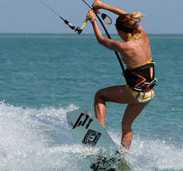 Your pop is going to spring you up off the water, and thus your front rotation needs to compliment this. In a standard front loop when the kite is utilized for height, you’re more than likely to throw your head and shoulders down and around to start rotating. This works because the kite gives you an up force.
Your pop is going to spring you up off the water, and thus your front rotation needs to compliment this. In a standard front loop when the kite is utilized for height, you’re more than likely to throw your head and shoulders down and around to start rotating. This works because the kite gives you an up force.
When popping, if you throw your head down towards your front shoulder, you’ll be neutralizing all the good work you’ve done getting up off the water by forcing your body weight down, and that would be counterproductive. Instead, you need to lift your chin and turn to look up and over the back shoulder as your rear leg extends, see picture on your left hand.
To some, this does not seem to be essentially wise, as you are straightening your back and turning it towards possible impact, whereas the original front loop was a safe roll as if you were crumpling up to break a fall. The second difference is your body can stay extended in a popped front loop, whereas in the jumped version, you are trying make yourself a bit compressed.
ALL IN THE HEAD
Your head is the key to completing this rotation. Half way around you are in prone position, because the kite will be pulling you forward, you will not be able to force your hips, legs and board around in front of you, while your legs are hanging behind and upwind of you.
To finish your spin, you’ll need to look over your shoulder at where you wish to go and then push your hands around to follow. By doing this, your upper body will be facing downwind and the rest will have to follow.
STEERING WHEEL
There is a tendency to pull on the back hand as you carve against the kite. This is more than normal, but it should be avoided. However, if you do find your kite drifting up, give it up a pull on your front hand and a push on the other hand as you come around your rotation. If this still doesn’t help, try pulling on your front hand as you take off.
ALL IN SEQUENCE
- Park the kite in 11 o’clock. Carve hard upwind for maximum pop. Put your weight low and towards the back on the board. Extend your front leg. Ride against the power of the kite whilst looking forward.
- As soon as you feel your shoulders being pulled forward over your hips explode off the water by rapidly extending your back leg.
- Your aim is to spring up and turn your head towards your right arm to initiate the rotation.
- As the kite pulls you forward continue the rotation and keep looking rounds towards your back elbow.
- You are now half way through this trick. You´re facing upwind and are fully powered so you better complete your rotation.
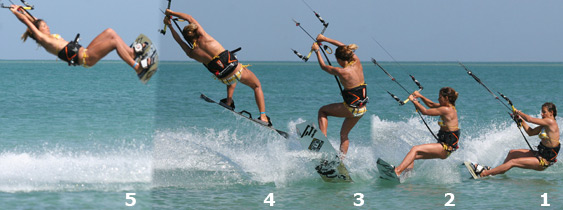
- Try to get a glimpse on where you´re going by spotting a potential landing.
- As your head comes around force your bar and hands around too.
- With your head and shoulders facing forward, the rest of your body follows and you can start dropping down your legs down under you.
- Land the tail first on preferable flat water, slightly off the wind. Soften the knees to absorb the landing and keep looking forward, not down in the water.
- Catch an eye on the kite to make sure that it´s not diving into the water, correct if necessary. Then keep heading towards the kite on a flat board.
- Time to take a hand off and hook back in.
BEST TIPS
Don’t take too much speed into this technique at first, as it’ll feel like you’re in a rush, yet alone rotate and land.
As you develop, you should try and start with the kite a tad lower and keep it still.
As you progress with more power, focus on popping up into the Raley first and then start your rotation.
If your kite is starting to misbehave and is hurling up away, try moving your back hand to the center of the bar with the chicken loop line running between your first two fingers.
A NICE VIDEO OF THIS TRICK
Front Loop from Toe side
Front Loop from Toe side
The front loop from toe side is an extra bit of fun for anyone who wants themselves as proficient toe combo specialists. It is a very attainable move and can lead into a surplus of combos and tricks, both hooked and unhooked, so this is a must have for any promising crowd pleasers around you. As you start from your toes, you’ll find that the kite does a lot of work for you when it comes to spinning. As long as you get the take-off and you keep controlling the kite’s atmosphere, it will be a well aligned move.
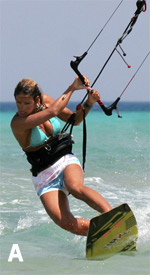 Pic A – The surfer is edging against the kite. Not wanting to draw too much attention to it, but this is another classic kite face trick. If you thought edging upwind requires some effort, now you will edge upwind and try to keep your weight low against the lift of the kite, you will need to use all your steel on it.
Pic A – The surfer is edging against the kite. Not wanting to draw too much attention to it, but this is another classic kite face trick. If you thought edging upwind requires some effort, now you will edge upwind and try to keep your weight low against the lift of the kite, you will need to use all your steel on it.
For starters, trim your bar down towards you. With the bar nearer your body, you will be able to edge well with both hands on the bar, thus being able to send the kite and keep the control on it. Even though the surfer’s bar is angled back to send the kite, the front arm is still bent slightly, so the kite doesn’t pull the surfer around. You can see how the surfer has his neck twisted and face really looking over his shoulder and down. This allows the surfer to commit against the kite and keep the body weight low and forward, whilst still keeping both hands on the bar. This way the surfer is able to hold the edge for that a little bit longer. Just like with a heel side jump move. If the surfer has a cheeky peek at the kite, it will come off the edge.
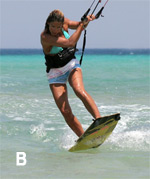 Pic B – Demonstrated the take-off perfectly. The surfer has popped up off the water after the feeling of the rising kite has been felt. Even though you use the kite for this trick, you need to “go early” because you’ll not be able to resist the same way that you do on your heels. Even though the surfer is extending up, keep the head down and twisted around plus continue to commit the weight upwind against the pull of the kite. It is tempting to drift the kite up slowly, but if you are fairly aggressive, you have more chance of holding your edge until the right time. This is your only chance to give yourself enough height to complete the move.
Pic B – Demonstrated the take-off perfectly. The surfer has popped up off the water after the feeling of the rising kite has been felt. Even though you use the kite for this trick, you need to “go early” because you’ll not be able to resist the same way that you do on your heels. Even though the surfer is extending up, keep the head down and twisted around plus continue to commit the weight upwind against the pull of the kite. It is tempting to drift the kite up slowly, but if you are fairly aggressive, you have more chance of holding your edge until the right time. This is your only chance to give yourself enough height to complete the move.
Also, as the surfer starts to take-off, the bar levels have been off already. This is due to popping up early. As the surfer essentially loses the edge as the pop goes, the kite will fly further back as the surfer pendulum underneath it. Once again this is only possible because the surfer has the bar trimmed in near.
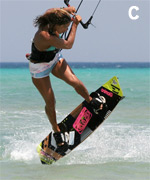 Pic C – The final part of the surfer’s take-off is the initiation of his forward rotation. Just as with a heel side front loop, much of the momentum comes from the back leg kicking off the water, and as the surfer popped off, his back leg will help in that phase. If you look at the surfer’s head, it is no longer looking upwind over his shoulder. By turning his head to look forward and downwind, his body will automatically start to uncoil, and this is a further help by the kite pulling in the harness hook.
Pic C – The final part of the surfer’s take-off is the initiation of his forward rotation. Just as with a heel side front loop, much of the momentum comes from the back leg kicking off the water, and as the surfer popped off, his back leg will help in that phase. If you look at the surfer’s head, it is no longer looking upwind over his shoulder. By turning his head to look forward and downwind, his body will automatically start to uncoil, and this is a further help by the kite pulling in the harness hook.
From here onwards it is all about keeping the bar in and keeping the kite forward while getting your body tucked up and small, so that you can look over your back shoulder and complete the rotation.
Sequences
1-2. With his kite at 1 o’clock and riding with good speed on his toe, the surfer edges hard and sends his kite back for a jump whilst trying to look upwind.
3. As the kite starts to lift up, the surfer explodes up off his back leg whilst committing his weight upwind and of the board.
4. As the surfer kicks off, turns his head and looks downwind under the bar. At this point the surfer is already redirecting the kite forward with his front hand.
5. This impulse coupled with the pulling of the kite, the harness throws the surfer into a front rotation. You can see how the surfer is pulling hard on his front hand.
6. This looks familiar. The surfer is now facing upwind and it looks exactly like a normal front loop. The surfer has the bar pulled in to keep the tension on the lines, the surfer is looking over his back (left) shoulder to continue rotating combing with his knees pulled up to increase the speed of the rotation.
7-8. The surfer keeps looking over his shoulder in an effort to see the water and where to land.
9. As the surfer completes his rotation. The surfer dives the kite hard with his front hand and focuses on his landing.
10. The diving kite pulls the surfer off downwind and stops his rotation. Now the surfer can drop his feet and is ready for the landing stage.
11. The surfer lands tail first with his board pointing downwind for a clean landing. From here the surfer can gather his thoughts before carving back onto his edge and not spinning his bar.
Keystones
1. Trim your kite to get the bar close
2. Edge hard by turning your head upwind
3. Send the kite (do not drift it.)
4. Pop early and turn your head the opposite way
5. Redirect with meaning
And the video:


